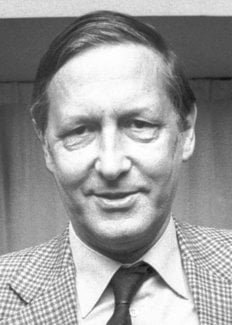Simon van der Meer
Biographical

I was born in 1925, in The Hague, the Netherlands, as the third child of Pieter van der Meer and Jetske Groeneveld, both of Frisian origin. I had three sisters.
My father was a schoolteacher and my mother came from a teacher’s family. Under these conditions it is not astonishing that learning was highly prized; in fact, my parents made sacrifices to be able to give their children a good education.
I visited the Gymnasium in The Hague and passed my final examination (in the sciences section) in 1943. Because the Dutch universities had just been closed at that time under the German occupation, I spent the next two years attending the humanities section of the Gymnasium. Meanwhile, my interest in physics and technology had been growing; I dabbled in electronics, equipped the parental home with various gadgets and assisted my brilliant and inspiring physics teacher (U.Ph. Lely) with the preparation of numerous demonstrations.
From 1945 onwards, I studied “Technical Physics” at the University of Technology, Delft, where I specialized in measurement and regulation technology under C.J.D.M. Verhagen. The physics taught in this newly created subsection of an old and established engineering school, although of excellent quality, was of necessity somewhat restricted and I have often felt regrets at not having had the intensive physics training that many of my colleagues enjoyed. Nevertheless, if I have at times been able to make original contributions in the accelerator field, I cannot help feeling that to a certain extent my slightly amateur approach in physics, combined with much practical experience, was an asset.
After obtaining my engineering degree in 1952, I worked in the Philips Research Laboratory, Eindhoven, mainly on high-voltage equipment and electronics for electron microscopes. In 1956 I moved to Geneva to join the recently founded European Organization for Nuclear Research (CERN), where I have been working ever since on many different projects, in an agreeable and stimulating international atmosphere.
To start with, my work (under the leadership of J.B. Adams and C.A. Ramm) was concerned mainly with technical design: poleface windings, multipole correction lenses for the 28 GeV synchrotron and their power supplies. My interest in matters more directly concerned with the handling of particles was growing, in the meantime, stimulated by many contacts with people understanding accelerators. After working for a year on a separated antiproton beam (1960), I proposed a high-current, pulsed focusing device (“horn”) aimed at increasing the intensity of a beam of neutrinos, then at the centre of interest at CERN and elsewhere. The design of this monster, together with the associated neutrino flux calculations kept me busy until 1965, when I joined a small group, led by F.J.M. Farley, preparing the second “g-2” experiment for measuring the anomalous magnetic moment of the muon. I designed the small storage ring used and participated at all stages of the experiment proper, including part of the data treatment. This was an invaluable experience; not only did I learn the principles of accelerator design, but I also got acquainted with the lifestyle and way of thinking of experimental high-energy physicists.
From 1967 to 1976 I returned to more technical work when I was responsible for the magnet power supplies, first of the Intersecting Storage Rings (ISR) and then of the 400 GeV synchrotron (SPS). I kept up with accelerator ideas, however, and worked (during my ISR period) on a method for the luminosity calibration of storage rings and on stochastic cooling. The latter was, of course, aimed at increasing the ISR luminosity, but practical application seemed difficult at the time, mainly because the high beam intensity in the ISR would have made the cooling very slow. After developing a primitive theory (1968) I therefore did not pursue this subject. However, the work was taken up by others and in 1974 the first experiments were done in the ISR.
In 1976, Cline, McIntyre, Mills, and Rubbia proposed to use the SPS or the Fermilab ring as a pp collider. Accumulation of the needed antiprotons would clearly require cooling. At this time, my work on the SPS power supplies had just come to an end; I joined a study group on the pp project and an experimental team studying cooling in a small ring (ICE). The successful experiments in this ring and the work by Sacherer on theory and by Thorndahl on filter cooling showed that p accumulation by stochastic stacking was feasible. The collider project was approved and I became joint project leader with R. Billinge for the accumulator construction. Since then, I have worked with the group that commissioned and improved the ring and that is now preparing the construction of a second ring to increase the p stacking rate by an order of magnitude. As a spin-off from this work, I proposed the stochastic extraction method that is now used (in a much improved form) in the Low-Energy Antiproton Ring (LEAR).
In the meantime, in 1966, while skiing with friends in the Swiss mountains, I met my wife-to-be Catharina M. Koopman and after a very brief interval we decided to marry. This was certainly one of the best decisions I ever made; my life has since been far more interesting and colourful. We have two children: Esther (1968) and Mathijs (1970).
(added in 1991):
In 1990 I retired from CERN.
Horzours Loeb Lecturer, Harvard University, 1981.
Duddell Metal, Institute of Physics, 1982.
Honorary Degree, Geneva University, 1983.
Honorary Degree, Amsterdam University, 1984.
Foreign Honorary Member, American Academy of Arts and Sciences, 1984.
Correspondent, Royal Netherlands Academy of Sciences, 1984.
This autobiography/biography was written at the time of the award and first published in the book series Les Prix Nobel. It was later edited and republished in Nobel Lectures. To cite this document, always state the source as shown above.
Simon van der Meer died on 4 March 2011.
Nobel Prizes and laureates
See them all presented here.
